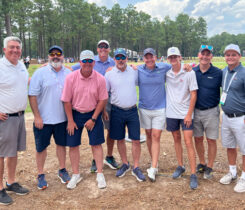Closer look: Indemnify, a new nematode control product
Rob Golembiewski, Ph.D., is a green solutions specialist with Bayer Crop Science. His responsibilities include assisting golf course superintendents, distributor sales reps and other end-users in solving problems and deciding how to effectively use Bayer products. Rob can be reached at rob.golembiewski@bayer.com for more information.
Q: What is the background of Indemnify (fluopyram) and its pathway to the marketplace?
Like most products, fluopyram was launched in the agricultural markets first, then developed for use in the golf course industry. Fluopyram, the active ingredient in Indemnify, is a succinate dehydrogenase inhibitor, or SDHI fungicide. Unlike other SDHI fungicides, fluopyram was identified as having nematicidal activity.
In addition to the extensive Indemnify testing by Bayer scientists, Bayer worked collaboratively with university researchers over the past four years to conduct approximately 100 field trials.
Indemnify currently is available for superintendents in the South, and although it will officially launch for superintendents in the North in early 2017, it can be purchased by northern superintendents on an as-needed basis.
Q: What is the mode of action of Indemnify, and what nematode species does it control?
Indemnify is a contact nematicide with acropetal (upward) systemicity within the turf plant. Fluopyram inhibits cellular respiration in nematodes, reducing the production of ATP, which is the energy source for
nematodes.
Indemnify provides both preventive and curative control of numerous endo- and ecto-parasitic nematode speIndemnify, Bayer, Rob Golembiewscies, including sting, root-knot, ring, stunt and Anguina pacificae. Research has shown inconsistent control of stubby root and sheath nematodes, and limited activity on lance and spiral nematodes. Additional research and widespread use of Indemnify on golf courses will expand the knowledge base of nematode species and the range of activity.
Q: What is the best strategy for a superintendent to follow when controlling nematodes with Indemnify?
On golf courses with a history of nematode problems or courses that have a confirmed laboratory diagnosis of damaging nematode populations, Indemnify should be applied once in the spring and once in the fall at 0.39 fl. oz./1,000 sq. ft., which is the maximum use rate for a single application. On golf courses with a more severe nematode problem, including thinning or loss of turf, Indemnify should be applied at 0.39 fl. oz. /1,000 sq. ft. twice in the spring and twice in the fall at two- to four-week intervals. To maximize effectiveness, Indemnify should either be watered in with 0.1 inch immediately following application, or it should be done that evening with the normal irrigation cycle.
Depending on turf health prior to Indemnify application and the growing conditions following application, it may take two to four weeks to see improvement in turf growth and
performance.
Q: Are there any environmental concerns with Indemnify, and are there safety concerns for turfgrass?
Proper stewardship always is important for any pesticide. Fortunately, Indemnify has a favorable environmental and non-target profile, binding moderately tightly to organic matter. To prevent leaching of Indemnify out of the area of nematode activity, avoid applying prior to significant rainfall in the 48-hour forecast.
Indemnify can be applied to all turf species and turf sites, including golf course putting greens, tees and fairways. There are no closure or re-entry interval restrictions following an Indemnify application. The turf can be used or played on once the spray solution has dried.
Q: Anything else you would like to add?
Fluopyram, the active ingredient in Indemnify, also has fungicidal properties. Bayer is launching a new fungicide in 2017, Exteris Stressgard, which is a combination of fluopyram and trifloxystrobin with Stressgard Formulation Technology. Exteris SG will have a far lower concentration of fluopyram than Indemnify, and will be labeled for control of foliar diseases such as dollar spot, brown patch, leaf spot and Microdochium patch. There is anecdotal evidence to suggest Indemnify has activity on some soil-borne diseases, but additional research is needed.











1 Comment on "Closer look: Indemnify, a new nematode control product"
Trackback | Comments RSS Feed
Inbound Links